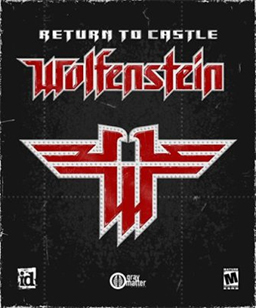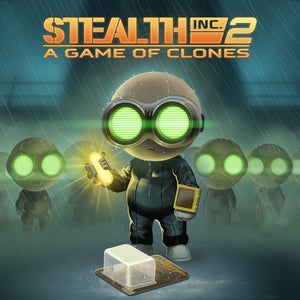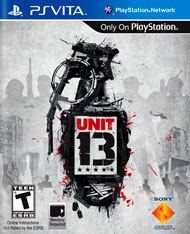
Return to Castle Wolfenstein is a first-person shooter video game published by Activision, released on November 20, 2001, for Microsoft Windows and subsequently for PlayStation 2, Xbox, Linux and Macintosh. The game serves as a reboot of the Wolfenstein series. It was developed by Gray Matter Studios and Nerve Software developed its multiplayer mode. id Software, the creators of Wolfenstein 3D, oversaw the development and were credited as executive producers. The multiplayer side eventually became the most popular part of the game, and was influential in the genre. Splash Damage created some of the maps for the Game of the Year edition. A sequel, titled Wolfenstein, was released on August 18, 2009.

Hitman 2: Silent Assassin is a 2002 stealth video game developed by IO Interactive and published by Eidos Interactive for Microsoft Windows, PlayStation 2, Xbox and GameCube. The game was re-released for Windows through the Steam online distribution service, and a DRM-free version was later made available through GOG.com. It is the second installment in the Hitman video game series and the sequel to Hitman: Codename 47. The single-player story once again follows Agent 47, a genetically enhanced human clone who worked for the International Contract Agency (ICA) as an assassin. Following the events of Codename 47, the former contract killer has retired and started a peaceful life at a church, but after his only friend, Reverend Emilio Vittorio, is kidnapped by unknown assailants, 47 resumes work for the ICA in hopes of tracking him down.
A stealth game is a type of video game in which the player primarily uses stealth to avoid or overcome opponents. Games in the genre typically allow the player to remain undetected by hiding, sneaking, or using disguises. Some games allow the player to choose between a stealthy approach or directly attacking antagonists, but rewarding the player for greater use of stealth. The genre has employed espionage, counter-terrorism, and rogue themes, with protagonists that are special forces operatives, special agents, secret agents, thieves, ninjas, or assassins. Some games have also combined stealth elements with other genres, such as first-person shooters and also platformers.
Hitman is a stealth video game franchise created by IO Interactive. In each installment, players assume the role of a cloned contract killer named Agent 47, who travels around the world to assassinate various targets that are assigned to him by the fictional International Contract Agency (ICA). Gameplay focuses on freedom of approach, with most levels placing the player in a large sandbox location where they have free rein to explore and find different ways to reach and eliminate their targets. Stealth is a major component of the gameplay and players are given various tools to accomplish their objectives, such as suppressed weaponry and the ability to take disguises, which allow 47 to blend in with non-player characters (NPCs) and bypass most restricted areas undetected.

SOCOM U.S. Navy SEALs: Fireteam Bravo 2 is a tactical shooter video game developed by Zipper Interactive and published by Sony Computer Entertainment for PlayStation Portable. It is the sequel to SOCOM U.S. Navy SEALs: Fireteam Bravo. This game is able to sync with the PlayStation 2 game SOCOM U.S. Navy SEALs: Combined Assault in order to unlock bonus features.

Flow is an independent video game created by Jenova Chen and Nicholas Clark. Originally released as a free Flash game in 2006 to accompany Chen's master's thesis, it was reworked into a 2007 PlayStation 3 game by his development studio, Thatgamecompany, with assistance from Santa Monica Studio. SuperVillain Studios developed a PlayStation Portable version of the game in 2008, and PlayStation 4 and PlayStation Vita versions in 2013. In Flow, the player navigates a series of two-dimensional (2D) planes with an aquatic microorganism that evolves by consuming other microorganisms. The game's design is based on Chen's research into dynamic difficulty adjustment at the University of Southern California's Interactive Media Division, and on psychologist Mihaly Csikszentmihalyi's theoretical concept of mental immersion or flow.

Tom Clancy's EndWar is a strategy video game available on Microsoft Windows and all seventh-generation platforms except the Wii, with the timing and flow of gameplay differing across platforms. The console and PC version is a real-time tactics game designed by Ubisoft Shanghai, while the handheld versions feature turn-based tactics. It was released on Nintendo DS, PlayStation 3, PlayStation Portable, and Xbox 360 on November 4, 2008, in the United States, November 6, 2008, in Canada, and November 8, 2008, in Europe. A Windows version was released on February 24, 2009. A PlayStation 2 version was cancelled.

Call of Duty 4: Modern Warfare is a 2007 first-person shooter video game developed by Infinity Ward and published by Activision. It is the fourth main installment in the Call of Duty series. The game breaks away from the World War II setting of previous entries and is instead set in modern times. Developed over two years, Modern Warfare was released in November 2007 for the PlayStation 3, Xbox 360 and Microsoft Windows, and was ported to the Wii as Call of Duty: Modern Warfare – Reflex Edition in 2009.
Wolfenstein is a series of World War II video games originally developed by Muse Software. The majority of the games follow William "B.J." Blazkowicz, an American Army captain, and his fight against the Axis powers. Earlier titles are centered around Nazis attempting to harness supernatural and occult forces, while later games are set in an alternate history in which Axis powers won World War II.

Shinobido 2: Revenge of Zen, known in Japan as Shinobidō 2: Sange, is a video game published by Spike in Japan in 2011 and Namco Bandai Games in North America and the PAL region in 2012. It was developed by Acquire, authors of the Tenchu and Way of the Samurai series, as a sequel to Shinobido: Way of the Ninja and Shinobido: Tales of the Ninja. A downloadable content pack, Mirror Spirits, was released on May 9, 2012. The game, along with its DLC, was removed from the PSN Store in 2016, most likely due to the license expiring from Bandai Namco in North America and the PAL region.

God Eater 2 is a video game developed by Shift and published by Bandai Namco Entertainment on November 14, 2013, in Japan for PlayStation Portable. It is a sequel to God Eater. It features a new setting, as well as new protagonists, new monsters, and new weapons. An expansion titled God Eater 2: Rage Burst was released in Japan on the PlayStation Vita and PlayStation 4. It was released in Western territories in summer 2016 with North American and European divisions of Bandai Namco Entertainment publishing the game on PlayStation 4, PlayStation Vita, and Microsoft Windows.

Rayman Legends is a platform video game developed by Ubisoft Montpellier and published by Ubisoft. It is the fifth main title in the Rayman series and the direct sequel to the 2011 game Rayman Origins. The game was released for Microsoft Windows, PlayStation 3, Xbox 360, Wii U, and PlayStation Vita platforms in August and September 2013. PlayStation 4 and Xbox One versions were released in February 2014, with a Stadia version released in November 2021. A Nintendo Switch port, titled Rayman Legends Definitive Edition, was released in North America, Europe and Australia on September 12, 2017.

Soul Sacrifice is an action role-playing video game developed by Marvelous AQL, with assistance from Japan Studio, and published by Sony Computer Entertainment for PlayStation Vita. It was released worldwide in 2013.

Oddworld: New 'n' Tasty! is a 2014 cinematic platform video game developed by Just Add Water and published by Oddworld Inhabitants as a "ground-up remake" of Oddworld: Abe's Oddysee. The game was released in North America on 22 July 2014 and in Europe on 23 July 2014 for the PlayStation 4. The title was also released for Linux, Microsoft Windows, OS X, Xbox One, PlayStation 3, PlayStation Vita, and Wii U. It has been ported on iOS and Android and released worldwide on 14 December 2017. A Nintendo Switch version was released on 27 October 2020.
Volume is an indie stealth video game developed by Mike Bithell Games. It was released for Microsoft Windows, OS X, and PlayStation 4 in August 2015, and the PlayStation Vita in January 2016. The game uses stealth mechanics inspired by Metal Gear Solid series, allowing the player to plan courses of action to work through levels without being detected by guards, dogs, and automated security turrets to reach specific objectives. In addition to the game's levels, Volume supports user-made levels that can be shared with others. The game presents a modern take on the Robin Hood legend, where a young thief discovers a plot for a military coup involving various heists, and uses a device called "Volume", with the assistance of its artificial intelligence to perform these heists in a virtual manner and broadcasting them to the world at large to make the coup known. The story is presented with the help of voice actors Charlie McDonnell, Danny Wallace, Dan Bull, James Stephanie Sterling, and Andy Serkis.

Helldivers is a top-down shooter game developed by Arrowhead Game Studios and published by Sony Computer Entertainment. The game was released for PlayStation 3, PlayStation 4 and PlayStation Vita with cross-play, on March 3, 2015 in North America and on March 4, 2015 in Europe, respectively. A version for Microsoft Windows was also released via Steam on December 7, 2015, making it the first game Sony published for PC.

Final Fantasy X/X-2 HD Remaster is a high-definition remaster of the role-playing video games Final Fantasy X (2001) and Final Fantasy X-2 (2003), originally developed by Square on the PlayStation 2 in the early 2000s. It also features story content previously only found in the International versions, and a new audio drama set a year after the events of X-2. The collection saw graphical and musical revisions and is based on the international versions of both games, making certain content accessible to players outside of Japan for the first time.

Stealth Inc 2: A Game of Clones is a 2D puzzle platform video game which was developed and published by Curve Digital. The game is a sequel to Stealth Bastard Deluxe, featuring different mechanics which involve puzzle sections. The game was released for the Wii U on October 23, 2014. The PlayStation 3, PlayStation 4, PlayStation Vita, Xbox One and Microsoft Windows versions of the game were also released in April 2015.

Grand Kingdom is a tactical role-playing video game developed by Monochrome Corporation for the PlayStation 4 and PlayStation Vita. It was published by Spike Chunsoft in Japan in 2015, and NIS America in the West in 2016. Following a mercenary group in the employ of different nations formed in the wake of a collapsed empire, the player engages in turn-based combat while navigating paths on maps similar to a board game. Online competitive asynchronous multiplayer where chosen teams of characters fight for a chosen nation was originally featured, but this ended as servers were shut down by 2019 in the West and 2022 in Japan.

The World Is Not Enough is a first-person shooter video game developed by Black Ops Entertainment and based on the 1999 James Bond film of the same name. It was published by Electronic Arts and released for the PlayStation on November 7, 2000, shortly after the release of its Nintendo 64 counterpart. The World Is Not Enough is the successor to Black Ops Entertainment's 1999 title Tomorrow Never Dies and uses an improved version of its engine. The game received mixed reviews from critics, who criticised its short length and lack of multiplayer mode.
















